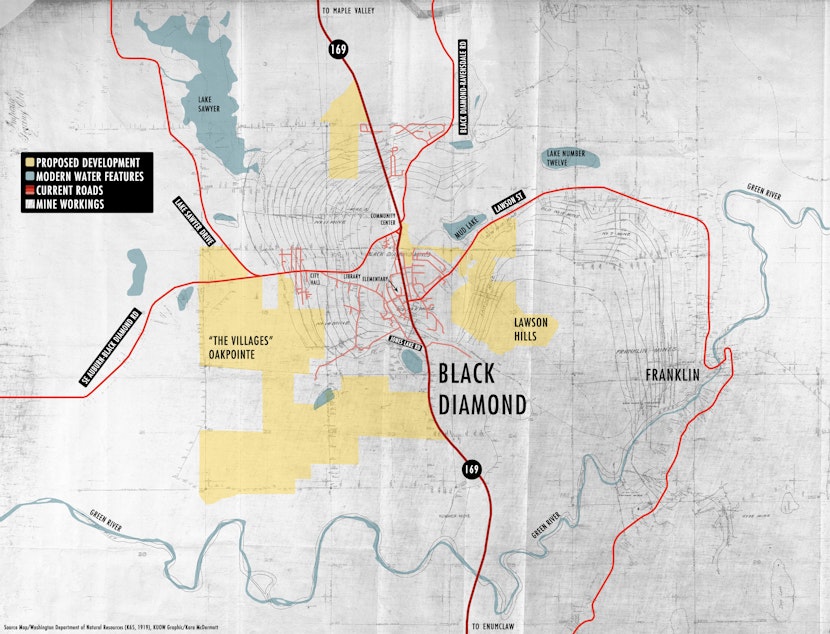Those new Black Diamond houses could be built atop mine shafts

A mega housing development is going up in Black Diamond outside Seattle, and some of those houses could be built on top of old mine shafts.
People buying a new home in this so-called “mine hazard area” would have to sign an agreement not to sue the City of Black Diamond. In signing this agreement, homeowners say they understand the information they get about the ground beneath may be iffy.
Here's a snippet from the covenant, or homeowner’s agreement:
“The City does not vouch for the accuracy, completeness or reliability of this data, and (homeowners) expressly understand such data is not intended to be and should not be relied upon in determining if the above-described property is a suitable site for any construction.”
There's good reason the agreement says the information can't be trusted: It's because there isn't much.
Tim Walsh, an assistant state geologist for the Department of Natural Resources, told KUOW by email that putting together a complete picture of the mining in Black Diamond would be difficult, if it is even possible.
We took a look at the maps available on Department of Natural Resources' website to see what information was available, focusing on the one that covered the largest area. The problem: It's a hand-drawn map from 1919. Likely it was never complete, and certainly it doesn't include the subsequent mining that has occurred.
Black Diamond isn't the only Seattle suburb with abandoned coal tunnels and mine shafts running beneath it. More developed cities such as Issaquah, Renton, Bellingham and Newcastle on the Eastside, sit atop old mines.
It was in Newcastle, according to the state Department of Natural Resources, that a sinkhole caused by a collapsing coal tunnel created the most damage. The hole opened up beneath a home off the Coal Creek Parkway in Newcastle in the 1980s.
The hole was not big enough to swallow the whole house, said Tim Walsh, assistant state geologist at Washington’s DNR. “The hole when it opened up was probably no more than 10 feet in diameter.”
It damaged a corner of the house — which was very expensive, but not fatal to the house or its occupants.
In Black Diamond, the Palmer Coking Coal company hasn’t mined in the area for years. Manager Bill Kombol said people should not be overly concerned about a coal tunnel collapsing and wrecking their house.
He said retreating mining companies tended to take out supporting structures on their way out, precipitating tunnel collapses. He said time also reduces the potential hazard.
"Most collapse happens in the first couple of years after abandonment,” he said. “So we're now on year 90, right here."
The depth of the tunnel is also an issue. The closer to the surface, the more of a hazard it poses.
But it's hard to get specific information. The state keeps a database of old mining maps. Newer maps from the Black Diamond area are from the 1950s or older (most are from the 1920s). The City of Black Diamond puts out an information sheet and has a map that provides a rough idea of the hazard area. (That map was recently drawn up by a local company a few years ago.)
It's been decades since the state has recorded real danger from a tunnel collapse around Black Diamond. Geologist Walsh said the last time was in the 1980s.
“A tunnel that was under the Green River Gorge Road burst,” he said. “It could have been serious.”
But no one was hurt. A woman driving with children saw a puddle in a new place. She stopped the car. “That was just before the edge of the road failed. And water sort of explosively came out of the mine across the road.”
Walsh said coal mine tunnels tend to be too small to consume an entire house.
So there's probably greater danger from our region's natural threats, like earthquakes, mudslides and volcanic mudflows — the ones we share, whether we live in the city or the distant suburbs.
Kara McDermott can be reached at kara@kuow.org. Have an idea about a community or a growth issue we could cover? Tell us here.
